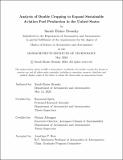Analysis of Double Cropping to Expand Sustainable Aviation Fuel Production in the United States
Author(s)
Demsky, Sarah Elaine
DownloadThesis PDF (8.991Mb)
Advisor
Speth, Raymond
Allroggen, Florian
Terms of use
Metadata
Show full item recordAbstract
Sustainable aviation fuels (SAFs) have been identified as a short to mid-term solution for reducing aviation carbon emissions. However, the industry is limited by cropland availability. This thesis analyzes the suitability of double cropping in the United States as a method to expand biomass for SAF production. The suitability for double cropping is quantified for 2020, 2035, 2050, and 2100, using temperature and rainfall data and regional projections. Twelve double crop pair combinations were studied for seven crop feedstocks using the hydroprocessed esters and fatty acids (HEFA) and alcohol to jet (ATJ) via ethanol pathways for conversion. The maximum SAF potential was quantified with current land use considerations, and showed that today, double cropping can increase SAF production by 268% to 464% compared to single cropping alone, depending on the land turnover time between crops. When allocating SAF production for minimum land usage, jet demand was met mostly by ATJ feedstocks. When allocating jet demand for maximum emissions savings, SAF production was almost entirely HEFA feedstocks. Based on the current climate, employing double cropping to meet jet fuel demand with 100% SAFs can lower total U.S. carbon emissions by 3.48% if optimized for maximum emissions savings, or 2.87% if optimized for minimum land use (including co-product emissions savings), compared to using entirely Jet-A. Overall, this thesis shows that double cropping can significantly expand SAF yields and has the potential to lower the carbon emissions of the U.S. aviation industry.
Date issued
2023-06Department
Massachusetts Institute of Technology. Department of Aeronautics and AstronauticsPublisher
Massachusetts Institute of Technology